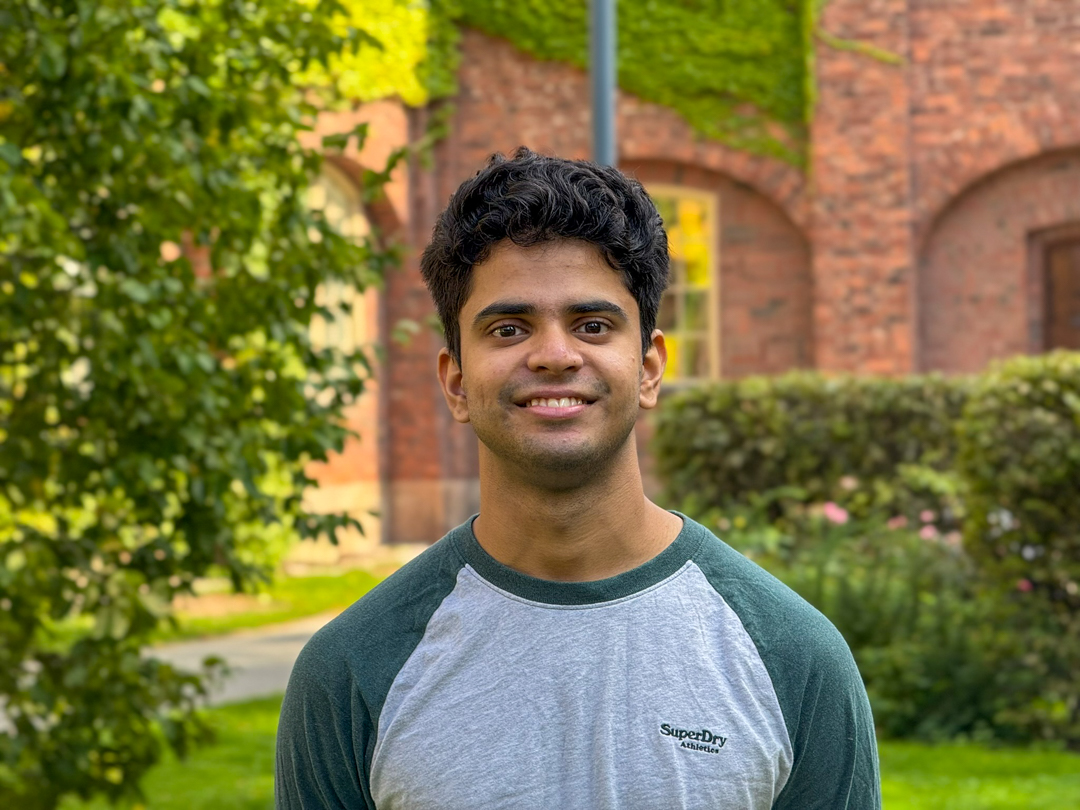Ritvik
Ritvik is from India and is pursuing an MSc in Systems, Control, and Robotics at KTH. He holds a bachelor's degree with honours in Electrical Engineering from the Indian Institute of Technology, Roorkee. He enjoys playing the guitar, badminton, and tennis in his free time.

Why did you choose this master’s program at KTH?
I developed a strong interest in robotics and control during my undergraduate studies. This field combines rigorous theoretical foundations with exciting real-world applications. Thus, during my undergraduate studies, I took various courses on control theory, joined the student robotics team, and did various internships and projects in these areas, which further developed my interest in pursuing higher studies. KTH stood out to me for several reasons. It is globally recognised for its strengths in robotics and control, and I have been following the work of several professors whose research has greatly inspired me. KTH’s strong academic reputation in Europe and the opportunity to study in a vibrant and innovative environment like Stockholm made it an ideal choice. Receiving the KTH Scholarship also helped significantly, easing the financial challenges often faced by international students from developing countries.
What are the best aspects of your programme?
The master’s programme offers a wide variety of courses, ranging from foundational theoretical topics in systems and control to more applied subjects through project courses. If followed thoroughly, many courses provide a solid foundation for pursuing research or entering industry. The instructors offering the courses usually have a plethora of research experience in their respective fields, so if one is interested in knowing more about a topic, the sky is the limit. Most of the courses have assignments that are to be done in groups, which is something that I really like, as it teaches you to work in synergy in a team and makes you ready for working in industry or a research group after the master’s degree.
Have you chosen a specialisation track within the program? Which track and why?
The master’s programme has two specialisation tracks: Learning, Decision and Control Systems (LDCS) and Robotics and Autonomous Systems (RAS). While each track has a couple of mandatory courses, students have the flexibility to choose electives across both tracks, so the tracks don’t really put a restriction on one’s choices. The LDCS track is meant to target the more theoretical aspects of the field, with a focus on subjects in control theory, mathematics, and machine learning, while the RAS track focuses on more applied areas like computer vision. I am more inclined towards the theoretical concepts in controls and machine learning, and thus I chose the LDCS track.
What are some of your favourite courses so far?
From the courses I have taken till now, I really liked Reinforcement Learning and Modelling of Dynamical Systems. The Reinforcement Learning course offers a strong mathematical foundation for a field that’s currently generating a lot of excitement, and the hands-on assignments in Python help bridge theory and practice. The Modelling course, on the other hand, highlights the importance of constructing accurate and useful system models, often an underappreciated but crucial aspect of control theory, using both first-principles and data-driven approaches.
How do studies at KTH differ from your previous studies?
The structure at KTH is quite different from what I was used to at IIT Roorkee. The foremost difference is in the semester system: Instead of two long semesters per year, KTH follows a four-period system, with around two courses per period. Completing a course in a couple of months, as compared to five months, means that you must learn more material in less time, while doing only two courses at a time, as compared to five, also means that you have more time and capacity to focus on the courses. I really like the fact that most of the assignments and labs involve some programming or other practical stuff, compared to mostly just solving problems on a piece of paper. Unlike my undergraduate studies, most of the courses here allow for lecture notes/slides and other helping material during the exams, and the exam duration is also longer (5 hours compared to the standard 3 hours at IIT Roorkee). I feel that this method of evaluation ensures that the students can put their best foot forward and showcase their learning in a better way with less stress.
How is student life in Stockholm?
Coming from a system where all the students usually live in hostels and don’t really need to cook or do most other chores, since the university provides food and other services, I had a huge change when I arrived in Stockholm. Having to manage groceries, cooking, meal prepping, managing finances, booking laundry slots, etc., can be a bit daunting at first, but one gets used to it fast and, in some ways, also starts enjoying these things. I really like the closeness of nature to the city. From my accommodation in Lappis, I can walk to a (albeit small) beach in about five minutes. KTH is literally located at the edge of a national park, and walking in the forest is a really refreshing experience after a tiring day of lectures and studies. The city also has a wide range of good restaurants and cafés, clubs, museums, and hiking trails that offer a much-needed break from academics. Coming from an international background, I have felt that the people are also very welcoming and friendly.
What do you want to do after graduating?
I have been interested in doing research and pushing the boundaries of innovation in robotics and controls, and I wish to continue doing research after my graduation. I plan to pursue a PhD and continue exploring these fields in depth. KTH has already played a significant role in shaping my academic and professional journey, and I believe it will continue to be a strong foundation for my future aspirations.
